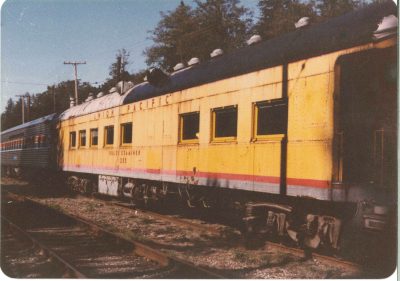Railroads are dangerous places. It’s often said that the rules are written in blood, as they were created in response to many serious accidents. However, that does not mean that railroads cannot be operated safely. Crews must be aware of their surroundings and be conscious of their task to keep everyone safe. This is why, even in the Museum’s rulebook, the very first rule is “Safety is of the utmost importance in the discharge of duty.”

When Union Pacific Café-Observation 1590 arrived at the Museum in the late 1970s, it was still in Armour Yellow as Rules Examiner 205.
Railroads helped their crews improve their safety-conscious thinking in a multitude of ways. Many railroads had instruction or rules cars that traveled across their system. These cars had open seating arrangements for use as a classroom or lecture hall. They could also double as a place for regular rules examination tests. Few of these examination cars were built new; often, railroads took retired passenger cars and rebuilt them after their passenger-hauling lives were done. The Museum’s Union Pacific Café-Observation 1590 was one such car, converted in 1948. It was renumbered to Rules Examiner Car 205 in 1955 and was used until 1970.
Many railroads also used the movie industry to film safety videos. The Great Northern Railway was no exception, filming a 35-minute-long film in 1947 titled Why Risk Your Life? It was filmed on location around the entirety of the Great Northern’s route, from St. Paul to Seattle. However, much of what crews did in 1947 that was considered safe and practical would be considered dangerous and not permitted today!

